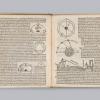Tabule astronomice Alfonsi Regis (Venice, 1492)
Commentary
The Alfonsine tables were one of the most popular tools for practical astronomy in the Middle Ages, and show us medieval methods of astronomical observation and calculation. Named after their sponsor, King Alfonso X of Castile (1221–84), they contain data used for computing the position of the Sun, Moon and planets relative to fixed stars. They were compiled in Toledo, Spain with astronomical data dating back to Alfonso’s coronation in 1252. To create the tables, Alfonso gathered a diverse group of Muslim, Jewish, and Christian scholars from Seville, Córdoba, Gascony, and Paris. They computed the tables using the methods of Claudius Ptolemy, whose geographical writings had a great influence on explorers of the fifteenth century, including Christopher Columbus.
The tables were constantly corrected and updated, and modified versions circulated in Europe from the 1320s. They were first printed in 1483, not long before the displayed edition. The tables were used until the mid-sixteenth century when they were superseded by other more accurate tables, such as Erasmus Reinhold’s Prutenic Tables (1551).

